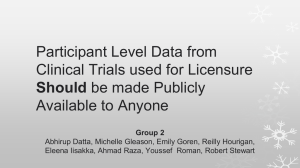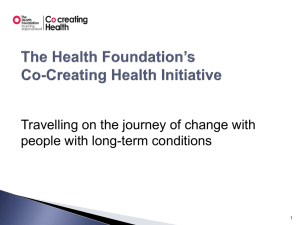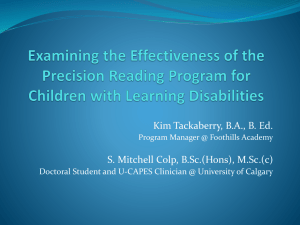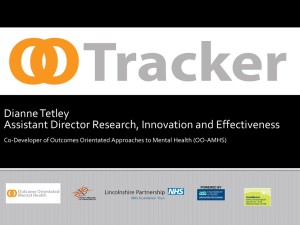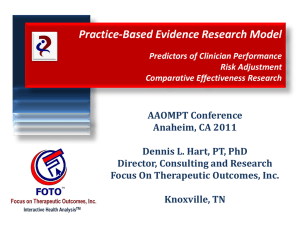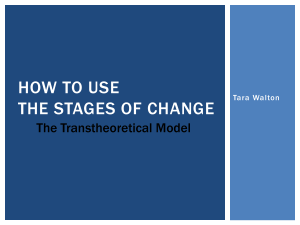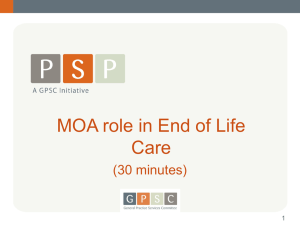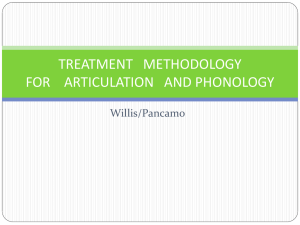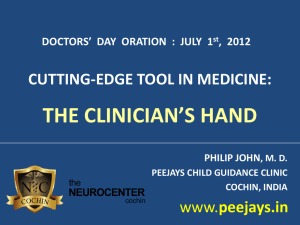Stages of Change and Treatment Matching - MI-PTE
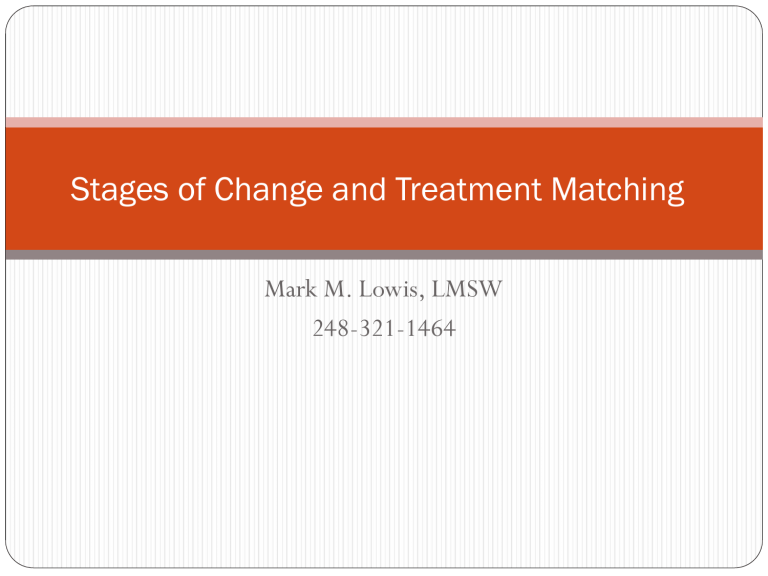
Stages of Change and Treatment Matching
Mark M. Lowis, LMSW
248-321-1464
Stages of Change Model*
Prochaska & DiClemente* (1982) characterized the stage-wise process that all people use in changing their behavior.
“Transtheoretical Model of Change” emerged from 18 psychological theories about how change occurs.
Is an internal intrapersonal process
Clinicians can be helpful by using strategies that are specific to individual stage of change.
Transtheoretical Change Process
HOW PEOPLE CHANGE
Maintenance
Precontemplation
Action
Preparation/Planning
Contemplation
ASSESS
Attitude, Intention, Past Efforts re: Change
Pre-
Contemplation
Raise doubt.
Contemplation
Explore ambivalence.
Determination
/
Preparation
Tip the balance.
Remove obstacles.
Initiate steps to change.
Action
Begin the change process.
Maintenance
Develop skills to maintain behavior.
Relapse
What have we learned?
Where are we now?
Start again based on stage of readiness.
“The Process Is the Message”
ASSESS
AGREE EXPLORE
4
The 4 R’s (DiClemente 1991)
Reluctant
Rebellious
Rationalizing
Resigned
Receptive/Deceptive (Zuckoff
2008)
Reluctance elicits discomfort
Rebellion elicits either “backing off” or “counter -aggression
Rationalizing elicits impatience
Resignation elicits hopelessness
Receptive/Deceptive elicits happy/hopeful feelings
I not ready for that
I’m not sure I need to
I’m afraid to
I can’t
Others?
I’m telling you right now, I’m not …..
You can’t make me…
I can do what I want in my own home…
When this is over I will do what I want,
I just won’t get caught….
Others?
There are people out there committing crimes way worse than…
Everyone does it…
My grandfather did and he lived to be 90
The law is unfair
I shouldn’t have to take medication…
Others?
Resigned
• There’s nothing I can do about it…
• We’ve always done it that way…
• If it happened again I’d do the same thing…
• The drugs I’m taking are the only thing that works. I can’t give them up…
• Its too hard….
Others?
I’ll do what ever you say
I know I need help
What should I do?
You really help me
I’m doing everything you say
Others?
Characteristics
Interpersonal
Styles
Interpersonal Styles are “ways of responding” to someone who is talking about and expecting change in something you’re not ready to change
Pre-Contemplation
• This is BS
• I don’t have a problem
• I don’t know what everyone is talking about
• I do the same things everyone else is doing
• I’m not going to change just because
• None of this makes sense
Others?
Contemplation
• I know I will have to do something eventually
• If I ever think I need to change I know I can do it on my own
• If it gets any worse then I will
• I’m not sure I need to yet
Others?
Preparation
• What am I supposed to do
• Where do I go
• How do I get started
• I would but I’m not sure what to do
Others?
Action
• So far is I’ve stopped (behavior) but I don’t know what else to do (early Action)
• I’m doing everything on my probation order but I can’t say once its over I will keep it that way (late action)
• I don’t want to go back to all of that mess
(Maintenance)
Others?
Precontemplation-Goal
Goal
•
Develop a collaborative relationship using strategies to demonstrate you accurately perceive the client’s world
•
Use collaborative relationship to explore perspectives that increase awareness of problem
Clinician’s role
Create an empathetic atmosphere in order to become able to:
–
Openly discuss problem behavior
–
Openly discuss consequences
Accept clients as they are
Elicit perspectives and feelings
Cultivate seeds of doubt
Pre-Contemplation
1.
Try to develop regular contact --meeting clients at a homeless shelter, community center, soup kitchen, coffee shop
2. Begin the process of developing a trusting relationship --be patient, accepting, persistent--be available when opportunity appears
3. Use reflective listening -listen carefully to the client’s view, reflect back without any attempts to interpret, offer advice, or correct misperceptions *
4.
Values Clarification -ask about what’s important to the client--values cards(my family, my children, my friends, helping others)
Pre-Contemplation
5.
Offer practical assistance - find out if there is a goal that the client would like to pursue, e.g. find own apartment, reconnect with family
6.
DON’T confront client about using substances - remain positive and optimistic, avoid confrontation and giving advice, emphasize hope, self-efficacy and client strengths
7.
A crisis may present an opportunity to further engage the client -forced sobriety can get clients thinking differently and having a relationship with CMH clinician is critically important
8.
MI Techniques --express empathy, ask open-ended questions, roll with resistance (join with client to explore rather than confront resistance), affirm, summarize
Pre-Contemplation
9.
Listen for change (engagement) talk - acknowledgement that substance use and psychiatric symptoms are interfering with goals, reflect back to client concerns
10.
Provide Information (feedback) about the effects and risks of use stay on neutral ground, ask them to explain about the effects, describe the addiction process, ask “What do you make of all of this?”
11.
Facilitate but don’t insist on entry into treatment and adhering to treatment recommendations - continue to elicit goals and talk about how treatment can help attain those goals
Contemplation
Task
Consider the costs and benefits of changing in order to make a firm decision
Goal
Complete a considered evaluation that leads to a decision to change
Clinician’s role: assist in attaining clarity on the benefits of maintaining the problem behavior vs. changing the behavior
Contemplation
Strategies:
1. Establish rapport/trust - expectations of treatment from clinician and client perspectives, explore the events that precipitated treatment entry, commend clients for coming
2.
Explore Goals and Values - (what I want from treatment survey)
“What things are most important to you? What would you like to have happen in treatment? How would you like your life to be different in 1 & 5 years?”
3.
Agree on direction - negotiate a pathway that is acceptable to the client (options), be straightforward about positive change, ask permission, reiterate that the choice to change is the clients
Contemplation
Strategies:
7.
Create doubt and evoke concern - goal is to raise doubts about the perceived harmlessness of their behavior and evoke concern that “all is not well after all”
8.
Ask about the pros and cons of substance use - good and not-so-good things about substance use--leave room to discuss the benefits of substance use
9.
Intervene through significant others - ask client first, screen for appropriateness, create a comfortable environment, teach MI strategies, stress that significant other is not going to monitor substance use, but is their to offer support
Preparation
Task
Increase commitment
Create a change Plan
Goal
Have an action plan to be implemented in the near future
Clinician’s role: to bolster commitment and collaborate with client to develop a specific plan, one that is tailored to personal needs and situation
Preparation
1.
Continue to build trust and support ct don’t suggest change, emphasize personal choice and responsibility
2.
Express empathy - reflective listening, make eye contact
3.
Develop discrepancy - continue to clarify CLIENT goals. Explore next steps to reach the goal(s); where they are at vs. where they want to be--impact of substance use and/or psychiatric symptoms on goals/aspirations/dreams
4.
Understand patterns and history of use - Develop a clear understanding of behavior patterns
Preparation
5.
Avoid argumentation/Roll with resistance - find an area where the client is ready to do some work, join with client to explore--DO NOT confront resistance
6.
Support self-efficacy - reduction as opposed to abstinence, success breeds self-efficacy and further success, explore what has worked in the past (situation confidence and readiness to change questionnaires)
7. Assess readiness to act - decreased resistance, fewer questions about the problem, resolution, selfmotivational statements, more ?’s about change, envisioning, and experimenting
Preparation
8.
Negotiate a Plan - change plan worksheet
9.
Offer a menu of options - treatment models
(e.g., social skills training , anxiety management, substance abuse counseling), community resources (e.g., halfway houses, support groups, social services)
10.
Contract for change - oral or signed, encourage clients to write their own contract (change plan worksheet)
Preparation
11. Lower barriers to action - help clients explore what options work best for them, consider specific strategies, help them anticipate any problems or obstacles to achieving their goals--get info on what has gone wrong in the past
12. Enlist social support - assess if social network supports/ sabotages abstinence, help build new social support network, AA, assess for poor social skills and refer if necessary to communication/assertiveness training(change plan worksheet)
13.
Pick a start date - make sure clients know they can call for encouragement and support, or re-negotiate the change plan
Action
Task
Implement strategies for change
Revise Plan as needed
Sustain commitment in face of difficulties
Goal
To take successful action to change current behavior pattern and maintain pattern for 3 to 6 months
Clinician’s role: to support client, help revise plan, assist in recognizing rewards, refer to appropriate resources, encouragement
Action
1.
Encourage and reinforce previous accomplishments, positive behaviors - provide support and/or additional avenues for support, coaching
2. Continue to discuss barriers to implementing action plan what’s working, what’s not
3. Conduct a functional analysis - patterns/history
4. Develop a coping plan - use with the functional analysis, anticipate problems before they happen and construct a list of alternative strategies-laminated cards
Action
5.
Elicit family and social support - determine which social relationships are supportive//risky, pinpoint reasons for using/not using different sources of support, identify gaps, help client develop early warning system with support person(s) who learns to recognize the triggers and signs that client is returning to substance use or “de-compensating”
6.
Develop competing reinforcers - source of satisfaction that can become an alternative to alcohol drug use, help client generate a list of pleasurable activities, e.g. recreational activities, volunteer work, 12-step activities, spiritual/cultural activities, learn new skills
Action
7.
Cognitive Behavioral Therapy - core beliefs, intermediate beliefs, automatic thoughts, compensatory strategies
8.
Detox, adjunct medications
9.
Development of a call list - a list of people the client can call when feeling vulnerable
10.
Recognition of rewards
Maintenance
(competing rewards)
Task
Sustain change over time and across a wide variety of situations
Goal
Maintain long-term change of the old pattern and continued practice of a new pattern of behavior
Clinician’s role: continue to offer reinforcement, help with problem solving, examine any threats to recovery, support personal growth and self-development
Maintenance
1.
Assess for erosion of commitment or overconfidence
2.
Continue to identify high-risk situations - using functional analysis and develop appropriate coping strategies
3.
Continue to explore new reinforcers of positive change see what has worked and hasn’t worked, develop new plan if necessary, unanticipated events
4.
Check-up - follow-up with clients/provide support, let them know they can come in for assistance
Maintenance
5.
Address other issues - significant unresolved issues
(marital problems, childhood abuse, stress)
6.
Support Personal Growth - switch focus to creating healthy sources of reinforcement-address empty life issues, peer mentoring
7.
Referrals returning to school, job skills training, more intensive individual/group counseling
8.
Skill development - learning to solve problems on own
9.
Transition - from treatment into natural community supports, social networks
Relapse/Recycling
1.
Refine Action Plan what worked, what didn’t, how you would do it differently
2.
Exploration of lifestyle problems - social isolation, lack of structured activity, issues with medication, use of other substances (caffeine, nicotine)
3.
Affirm the client’s resolve and self-efficacy look at slip as a learning experience
4.
Help client practice and use new coping strategies to avoid a return to use
Relapse/Recycling
5.
Make your self available to talk between sessions - or - develop a phone list of support people that client can call
6.
Discuss issues of “cold feet”
7.
Develop a “fire escape” plan if client slips
Stages of Change Model
• Think of “states” rather than “stages”
• Individuals move back and forth between the stages (nonlinear process)
• Can move through the stages at different rates.
• Not uncommon for people to linger in the early stages.
• We facilitate but do not impose change
• May be in different stages for different issues
Benefits of Assessing and Staging Internal
Motivation and Readiness
• Creates an assistive/collaborative relationship
• Provides additional tools
• Helps tailor specific interventions
• Gives you and client realistic expectations
• Enables you and the client to recognize accomplishments (small steps)
• Leads to greater success over time
• Results in less frustration and burn-out
Benefits of Staging Treatment
Readiness
• Knowing client’s SOT enables clinicians to provide a range of Tx options known to be effective for that stage provides a framework
• Staging helps clinicians to monitor client’s over time to determine whether or not they are making progress
• Allows programs to monitor cohorts/groups of clients over time to determine whether they are moving toward recovery at a realistic rate or if they are becoming stuck at particular points
Modified SATS
Stages of Treatment:
1. Pre-engagement The person does not have contact with a case manager, or mental health clinician.
2. Engagement The person has contact with an assigned case manager or mental health clinician, but does not have regular contacts.
The lack of regular contact implies lack of a working alliance.
Modified SATS
Stages of Treatment:
3. Early Persuasion The person has regular contacts with a case manager or mental health clinician at least once a month. Regular contacts imply a working alliance and a relationship in which target symptoms and behaviors can be discussed.
4. Late Persuasion The person is engaged in a relationship with a case manager or mental health clinician, is discussing target symptom(s) and behavior(s), and shows evidence of reduction in their targeted symptom and behavior, as agreed on in their
IPOS, for at least one month. External motivation (e.g. eyes on meds, ATO, probation or parole) may be involved in the reduction.
Modified SATS
Stages of Treatment:
5. Early Active Treatment The person is engaged in treatment, has been discussing targeted symptom and behavior reduction for at least one month, and is making consistent progress toward PCP goals, even though he or she may still be experiencing targeted symptoms or behaviors.
6. Late Active Treatment The person is engaged in treatment, has acknowledged that their targeted symptom and behavior are a problem, and has achieved reduction in the targeted symptom and behavior but for less than six months.
Modified SATS
Stages of Treatment:
7. Relapse Prevention The person is engaged in treatment, has acknowledged that their symptom and behavior is a problem, and has achieved a reduction in their targeted symptom or behavior for less than one year but greater than six months. Episodic symptoms or behaviors occur but do not reach the level of a crisis contact.
8. In Remission or Recovery The person has the skills to cope with their illness while engaging in ongoing life goals (e.g. independence, volunteering, work, school, etc.) for over one year.
The Stages of Change Model
Information and resources are available at
http://www.uri.edu/research/cprc/transtheoretical.htm
http://WWW.MotivationalInterviewing
SAMHSA:TIP 42
